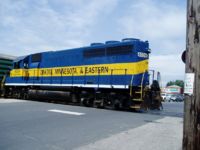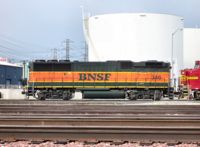Hood unit

A hood unit, in railroad terminology, is a body style for diesel and electric locomotives. On a hood unit, the body of the locomotive is less than full-width for most of the locomotive's length, with walkways on the outside of the locomotive. In contrast, a cab unit has a full-width carbody for the length of the locomotive. A hood unit has sufficient visibility to be operated in both directions from a single cab. Also, the underframe is the main load-bearing member, allowing the hood to be non-structural and easily opened or even removed for maintenance.
The visibility and access advantages mean that the hood unit is overwhelmingly the most popular style of locomotive in North America, as well as many other nations.
Although the crew cabin is centered on some hood units, in most cases the cab is closer to one end of the locomotive than the other, breaking the locomotive up into long hood and short hood sections. It is generally preferred to run a hood unit short hood forward so that the cab is closer to the front, but there is enough visibility in the other direction that they can run long hood forward at regular speeds. Some railroad companies (notably, the Norfolk & Western and the Southern) ordered locomotives with cabs facing long hood forward so that the short hood is actually the rear of the locomotives, but that practice has become increasingly rare. This was usually done to offer greater protection to the crew in the event of a collision. Other locomotives were set up with dual control stands so that they could operate in both directions, making it unnecessary to turn the locomotive around at the end of a run. Some cabless hood units were also built. The long hood ran the whole length of those locomotives. All locomotives are required to have the letter F printed on the side sill at the end which is normally operated as its front.
The long hood of a locomotive is usually about as tall as the cab roof in order to fit the large prime mover and the exhaust equipment. Originally the short hood of the locomotive was the same height, which is referred to as a high-nose or, confusingly, high short hood. This was originally done to avoid union conflicts, as the high nose ensured that two crewmen (one on each side of the cab) were required in order to see both sides of the track. After this issue was resolved, the height of the short hood was reduced to increase visibility, creating a low-nose or low short hood locomotive. Some locomotives that were originally built with a high nose were later modified to have a low nose. Lately it has become common to make the short hood not only lower but also full-width, creating a wider nose which is sometimes referred to as a safety cab.
The hood unit evolved from the switcher locomotive. A switcher's long hood is low enough that the crew can see over it, and there typically is no short hood. Alco introduced the road-switcher concept with the RS-1, which was an enlarged switcher with a short hood ahead of the cab. This was added to provide protection for the crew in case of a collision. The low long hood was retained, though its increased length made visibility over it useless. Later, EMD introduced the GP7, which had a similar layout, though both hoods were as high as the cab roof. The high long hood became standard for virtually all hood unit locomotives thereafter.
Freight-oriented hood units
Passenger-oriented hood units
- EMD SDP45
- GE Dash 8-32BHW

